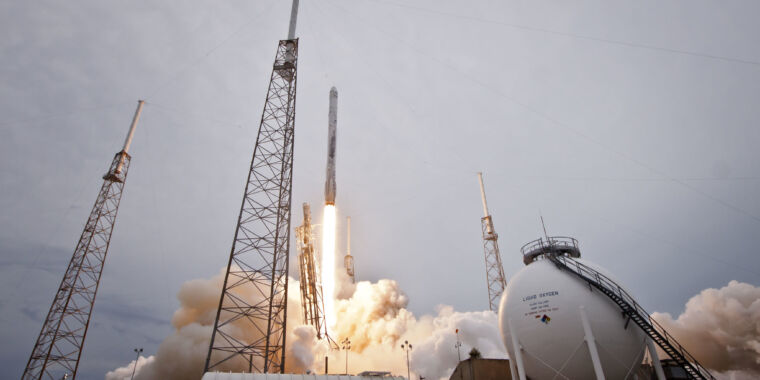The hidden story behind one of SpaceX’s wettest and wildest launches


SpaceX
Ten years ago today, when a Falcon 9 rocket took off from Florida, something strange happened. Dramatically, as the rocket lifted off, a fountain of dirty water splashed upward alongside the vehicle, coating the rocket in grime.
Following the ultimately successful liftoff of this third cargo Dragon mission to the International Space Station, SpaceX founder Elon Musk was asked about the incident during a news conference. He offered a fairly generic answer without going into the details.
“We sprayed a bunch of water all around the pad,” Musk said. “Essentially what happened is we splashed dirty water on ourselves. So it’s a little embarrassing, but no harm done.”
He was correct, but there’s more to the story. And on the 10th anniversary of the mission, it’s fun to revisit what actually happened. Before reading further, you may want to watch the launch webcast here, time-stamped to the final seconds before liftoff.
Flight nine delayed
In early 2014, SpaceX was still breaking in a new version of its Falcon 9 rocket, v1.1, and striving to increase the frequency of its launches. The company had completed a pair of commercial launches to geostationary transfer orbit in December and January—the first time it had ever flown in back-to-back months—and was pressing toward its third cargo supply mission for NASA, Commercial Resupply Services-3.
SpaceX initially targeted a window from the second half of January into the middle of February for this launch in 2014, but this was delayed due to a coolant leak on board the space station. NASA subsequently reset the launch date to February 22, and then March 1, and finally March 16. However, as this day neared, SpaceX asked for a two-week delay to address technical problems with Dragon.
But the problems persisted, including a fire on the Air Force base near the launch site that caused issues with radars used to track rockets in flight. Then, crushingly, an issue was discovered with the rocket’s stage separation system just one hour before a planned liftoff on April 14. Another delay.
All of these issues weighed heavily on the shoulders of a 30-something engineer named Ricky Lim, who had come to SpaceX in January 2008. After helping the company push through its Falcon 1 teething pains, Lim helped with the initial launches of the Falcon 9 rocket. Now, on the rocket’s ninth flight, Lim found himself planted in the hot seat in Cape Canaveral, Florida.
“That was my first launch sitting as launch director,” he said in an interview. “I was still drinking from the firehose.”
Lim’s seat would get hotter.
A small leak
As they got into a new countdown during the middle of the day on April 18, a problem cropped up with the ground systems used to fuel the Falcon 9 rocket. The launch teams started to see a small liquid oxygen leak in the ground-support equipment at a pipe fitting. A potent oxidizer in the combustion of rocket engines, liquid oxygen must be kept at very cold temperatures to prevent boiling, below minus-297° Fahrenheit (minus-147° Celsius).
By looking at temperatures and the video, Lim’s team determined this was not simply condensation, but rather something that could be potentially very hazardous. A large enough leak could create a pocket of concentrated oxygen and explode during engine ignition. Another concern was oxygen leaking onto adjacent pipes, which could crack pressurized lines and lead to bad outcomes with the rocket.
This leak was small enough that it did not necessitate an immediate halt to launch preparations. Some of the company’s more experienced engineers, such as Brian Childers and Mike Rossoni, understood that the problem might be ameliorated by ‘trickling’ water over the leaky pipe. The water could, in effect, provide a temporary fix to the leak by icing over it. This Flex-Tape-like solution allowed preparations to proceed and stave off yet another delay for the Dragon mission.
So, hours before liftoff, the launch team activated the “FireX” system in the relevant area of the launch pad. This fire suppression system is separate from the larger and more powerful water deluge system, which is activated seconds before liftoff to mitigate sound and energy from the rocket’s Merlin engines. FireX is used, typically, to control fires at the pad. Lim’s team set the fire hose in the relevant area at a lower setting, and it worked, allowing SpaceX to power through propellant loading.
However, the launch team didn’t have an effective way to measure the precise flow of water. And because it was activated hours before liftoff, over that time the trickle accumulated into quite a lot of water. At least tens of thousands of gallons, if not more, built up in the concrete flame trench beneath the rocket that carries gas and exhaust away from the vehicle during the initial seconds of launch. There was always some water in the trench at liftoff from the water deluge system, but never this much.
At the moment of liftoff, and in the ensuing seconds afterward, Lim was focused on the stream of telemetry returning information about the health of the Falcon 9. He barely spared a glance at the video and missed the giant plume. But Musk had been watching, and he called to ask what had happened. The answer soon became obvious—the FireX trickle.
“There was so much water in the flame trench that at liftoff it created this giant plume of dirty, soot-filled water, like the Bellagio fountain,” Lim explained. “It looked like a giant smoke monster.”
No huge repercussions
None of the official photographs from the launch captured the moment of the massive fountain, which shows up briefly on the webcast. However, the image below, taken by Walter Scriptunas II, offers a great view of the dirty plume near its peak.
Despite the smoke monster, the rocket never really was in all that much danger. Probably the biggest risk, Lim said, was that the huge plume of water might extinguish one or more of the rocket’s nine engines. But that didn’t happen.

A photo of the CRS-3 launch just a moment after liftoff showing the dirty water plume.
Back then every rocket launched by SpaceX was brand new, with a brilliant white sheen from fresh paint. However, launch photos from the day reveal that just seconds after liftoff, the booster was covered in grime. This is because the water that had collected in the flame trench was dirty and sooty. So when Musk said the rocket splashed dirty water on itself, he was correct.
Today, this SpaceX launch is now better known for becoming the first time a Falcon 9 rocket successfully made a soft landing in the Atlantic Ocean. The booster hit the water in an upright position, making a controlled flight all the way down through the atmosphere before toppling over into the sea.
And so the rocket’s flight ended as it began—with a righteous soaking.
Source link




